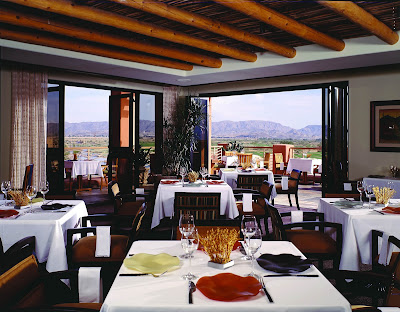Jack Strong takes Manhattan: Kai restaurant chef brings luxury Native cuisine to NYC
Published in Indian Country Today in 2007. For more on topics like this, see my book, American Apartheid: The Native American Struggle....
Chef Jack Strong, Confederated Tribes of Siletz Indians, spooned buffalo tartare — chopped raw meat, minced pickled cactus pads, capers and more — into little cones fashioned from miniature tortillas. Strong, the 31-year-old chef de cuisine of Kai Restaurant at the Sheraton Wild Horse Pass Resort & Spa (shown left), was in a sleek demonstration kitchen in midtown New York City. He and fellow chefs from the Phoenix-area resort, an AAA Five Diamond property managed by Starwood, were showing their innovative, heritage-food-based cuisine to food and travel journalists.
Many of the dishes included ingredients that were cultivated or gathered in the desert by the Akimel O’otham (also called Pima) and Pee Posh (or Maricopa) members of the Gila River Indian Community, which owns the resort, or obtained from other indigenous enterprises. The rich, tender buffalo in the tartare was from grass-fed animals raised on the Cheyenne River Sioux Reservation; tribal elders had taught Strong to make the soft-textured wheat tortillas, called chumath; and children at Gila Crossing Community School, a tribal elementary school, had grown the I’itoi heritage onions that flavored the diminutive breads.
As Strong assembled the cones, Michael O’Dowd, executive chef of the resort’s several restaurants, gently fried quail eggs and deposited them, sunny-side up, on top of the tartare. The tiny construction was almost too adorable to eat, yet one bite later, I understood its logic, as the silkiness of the egg smoothed over the assertive edges of the tartare. Synesthesia ruled another offering — a cold, chile-laced corn soup. The bright heat of the chiles mingled in the mouth with the cool pale-yellow purée, confounding the brain: which sensations derived from sight, which from taste, which from feeling? As the assembled journalists admired the cholla buds, mesquite honey and other indigenous specialties, Strong heaped on the glossy pearls of ossetra caviar, saying “And this caviar is from sturgeon swimming in our rivers.”
While the assembled journalists admired the cholla buds, mesquite honey and other indigenous specialties, Strong heaped on the glossy pearls of ossetra caviar, saying “And this caviar is from sturgeon swimming in our rivers.”
“Really?” gasped one viewer. “No!” laughed Strong, shaking his head. As he worked, Strong radiated energy and delight. “To be a Native chef doing Native cuisine with a supportive executive chef is amazing,” he said. “I’m in such a fun place. Almost every day at Kai, we get in new ingredients and experiment with them. We push the envelope in every way. Chef O’Dowd always says, ‘Let’s wow some people. Let’s make an impact.’”
Consulting chef Janos Wilder, a James Beard Award winner, has called Kai’s cuisine “a nod to the past and a look to the future…familiar, yet intriguing.” O’Dowd and Strong call it “Native American with world accents.”
After the demonstration, Strong and his colleagues did what chefs like to do when they’re not cooking. They ate out. They chose one of New York’s most elegant restaurants, Jean Georges, where the food is both seasonal and sophisticated. “We had an amazing twelve-course meal that lasted four hours,” said Strong. The Arizonans didn’t hold back; at the end of the evening, each consumed four to six desserts.
Strong grew up on the Siletz reservation, near the Oregon coast. Making meals for his grandparents, who raised him, was his introduction to cooking. “I got my creativity from my mother,” Strong said. “I lost her in a car accident when I was four, but I know she did a lot of cooking and baking. We were poor, so she often used her imagination to stretch food, but she also made things like homemade pizza. That was unusual for Oregon in those days.”
A high-school job at a local fish house, a tribal internship program that allowed him to work during his senior year in a nearby resort’s professional kitchen, then culinary school in Eugene, Oregon, developed his skills. His subsequent career encompassed working as an executive chef in a fine-dining eatery in Eugene and two years as sous chef of the celebrated Southwestern-style Windows on the Green restaurant at The Phoenician Resort in Scottsdale, Arizona. In 2006, he moved to Kai.
The work done at Kai (which means “seed” in the Pima language) and in the resort as a whole resonates throughout the tribal community. Strong, O’Dowd and other staffers attend career fairs at local schools. Because the Gila Crossing school garden sells produce to the resort, children learn that agriculture — the centerpiece of their heritage — provides a viable way to make a living, as well as a meaningful one. The resort is also a customer of Gila River Farms, a 16,000-acre tribal operation that purveys citrus fruits, olives and olive oil, among other items.
O’Dowd, who has been at Wild Horse Pass since it opened in 2002, is working with the facility’s cultural concierge, Ginger Martin, Pima, to develop a farmers market. “The community has just received a large water settlement, and with the greater availability of irrigation, we’re hoping to encourage more individuals to garden and sell us their heirloom crops,” said O’Dowd. “We want to help make the area an agricultural powerhouse.”
Food like Kai’s can’t be created hastily or in vast quantities. “We usually do just seventy covers [individual meals] per night, with the first guests arriving at about six o’clock and another group at about nine,” said Strong. “Most people spend at least two hours and have five to seven courses.”
In the future, he and O’Dowd plan to offer even longer tasting menus, with just one group of diners spending the entire evening on a meal. “We want people to walk away talking about the experience,” said Strong.
Text c. Stephanie Woodard; photos courtesy Kai restaurant.
Text c. Stephanie Woodard; photos courtesy Kai restaurant.



